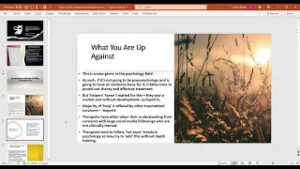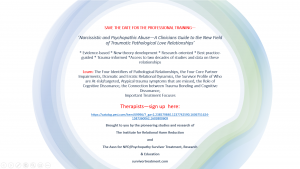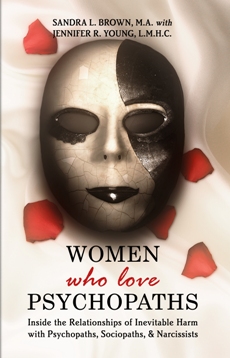Intrusive thoughts are associated with Post Traumatic Stress Disorder, as well as other emotional trauma disorders. Many survivors say that the most painful memories are not the intrusive thoughts of all the bad stuff, or even the violence—what is most painful is the intrusive thoughts of good memories.
Intrusive thoughts are not just bad thoughts or flashbacks. They can be intrusive from positive memories as well. Positive memories are embedded with deep emotional and psychological meaning. The meaning of the relationship, various happy moments, the deep feelings of attachment, fantastic sex—can all be power-packed into positive memories. Positive memories are also embedded with all the sights, sounds, smells, sensations, feelings, and the associated meanings of the events and remembrances of a happier time. The positive memories can also be tied up with a ribbon of fantasy and romanticized feelings. That’s a lot of power packed into a few positive memories, and has the “TNT emotional factor” that overrides your “stay-away-from-him” resolve.
All memories are not stored the same way. I’ve talked about this before in our books. Positive memory is stored differently in the brain, and is more easily accessible than some of the bad memories. Many traumatic memories are stored in another part of the brain that makes them harder to access. Sometimes the more traumatic they are, the harder it is to remember.
Unfortunately, what you might want to remember most is the bad part of the relationship, so it motivates you to stay away from getting back into it. But instead, you are murky, and are not always fresh in your mind about why you should be avoiding the pathological relationship. What IS easy to remember is all the positive memories. In fact, what has become intrusive is positive memory seepage. This is when all the good times and the associated senses (sight, touch, smell, etc.) are flooding your mind. You easily remember the good times and easily forget the bad times—all based on how and where these types of memories are stored in the brain. You may NEED the bad memories for emotional reinforcement; however, all you REMEMBER are the good ones.
That which is held internally is amplified. It’s almost like putting them under a magnifying glass—the feelings, memories, senses—are all BIGGER and STRONGER when the memories simply roll around in your head. It’s a lot like a pinball machine—memories pinging and ponging off the internal elements. The more they ping and pong, the stronger the memories move around the mind.
Memories kept in the mind also take on surreal qualities. Certain parts are like a movie—fantasy-based and romanticized. The positive memories are dipped in crystallized sugar and become tantalizing treats instead of toxic treats! While engaged in this positive memory seepage, it doesn’t feel like you are indulging yourself in toxic memories. It feels like you are trying to process the relationship—“Why did we do this?” “Did he say that?” “Why was it like that then, but it’s like this now?” It feels like what you are trying to do is to sort out the relationship. But all the sorting of this dirty laundry still leaves the same amount of soiled clothing piled in your head. You are just moving the same shirt from pile to pile. It’s still the same dirty laundry but nothing is getting cleaned up.
Positive memory seepage, as intrusive thoughts, is a big contributor to the cognitive dissonance women feel in the aftermath of these relationships. Cognitive Dissonance (or C.D., as we refer to it) is the difficulty of trying to hold two opposing thoughts or beliefs at the same time—it’s usually something like, “He’s good” AND “He’s bad”—“How can he be good AND bad?” Just trying to resolve that particular thought can leave a woman’s mind tangled up for years. C.D. can single-handedly take women down—it can cause them to be unable to concentrate, work, sleep, eat, or function overall. It’s like the image of the devil sitting on one shoulder and the angel sitting on the other, and they are both whispering in your ear. That’s exactly what C.D. is like—trying to decide which thing you are going to believe—that he’s bad for you, or that he’s good for you.
Positive memory seepage produces intrusive thoughts. Intrusive thoughts, especially about positive memories, produce cognitive dissonance. These emotional processes feed each other like a blood-induced shark fest. It’s one of the single reasons women don’t disengage from the relationship, heal, or return to a higher level of functioning.
Now that we’ve identified what is really at the heart of the aftermath of symptoms, we know that treating C.D. is really the most important recovery factor in pathological love relationships. It’s why we have developed various tools to manage it—Maintaining Mindfulness in the Midst of Obsession e-book and two CDs, as well as our retreats, 1:1s, etc.
The quickest way to recover is by learning to manage the intrusive thoughts and cognitive dissonance. A managed mind makes life feel much more manageable too!
(**If we can support you in your recovery process, please let us know. The Institute is the largest provider of recovery-based services for survivors of pathological love relationships. Information about pathological love relationships is in our award-winning book, Women Who Love Psychopaths, and is also available in our retreats, 1:1s, or phone sessions. See the website for more information).






